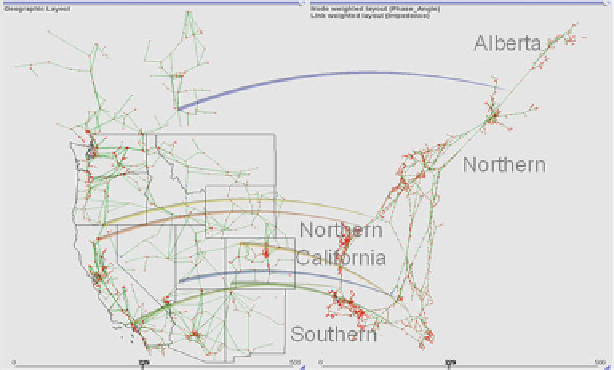Information Technology Reference
In-Depth Information
Fig. 9.10
Left
: The geographic layout of the Western Power Grid (WECC) with 230 kV or higher
voltage.
Right
: a GreenGrid layout with additional weights applied to both nodes (using voltage
phase angle) and links (using impedance) (Reprinted from Wong et al.
2009
with permission)
One example provided by visual analytics could potentially alleviate some of
the real-time situation awareness challenges facing power grid operators. The
GreenGrid system developed at Pacific Northwest National Lab (PNNL) extends
the traditional force-directed graph layout technique by integrating the physics of
the electrical circuit and the geography of the physical power grid resources into
one discourse analytics tool for continuous power grid monitoring, measurement,
and mitigation (Wong et al.
2009
). Figure
9.10
(left) shows a traditional power grid
visualization of the Western Power Grid (a.k.a. Western Electricity Coordinating
Council, or WECC) drawn on a geographic map. By modeling the telemetered
data using the attractive and repulsive forces of the WECC in Fig.
9.10
(right),
the operators could conduct contingency analysis as soon as they spot unusual
stretching of certain power grid links. On August 10, 1996, the Western Power Grid
was decoupled into four isolated islands (Alberta, Northern, Northern California,
and Southern) during the last blackout in western North America. A customized
visual analytics tool such as GreenGrid in Fig.
9.10
(right) could show early signs
of the decoupling, which would allow operators to assess the situation and enforce
mitigation at the earliest possible time.
While the GreenGrid technology seems effective, the multi-faceted power grid
analytics challenges will need an array of additional visual analytics technologies
to fully address the problems. Among them is the multivariate network analytics
problem, which potentially could be alleviated by the GreenCurve technology
(Wong et al.
2012
). Both the GreenGrid and the GreenCurve visual analytics
technologies could be modified to address other critical infrastructure network
problems from telecommunication, to energy, to transportation network grids that
require real-time human monitoring and responding.

Search WWH ::

Custom Search